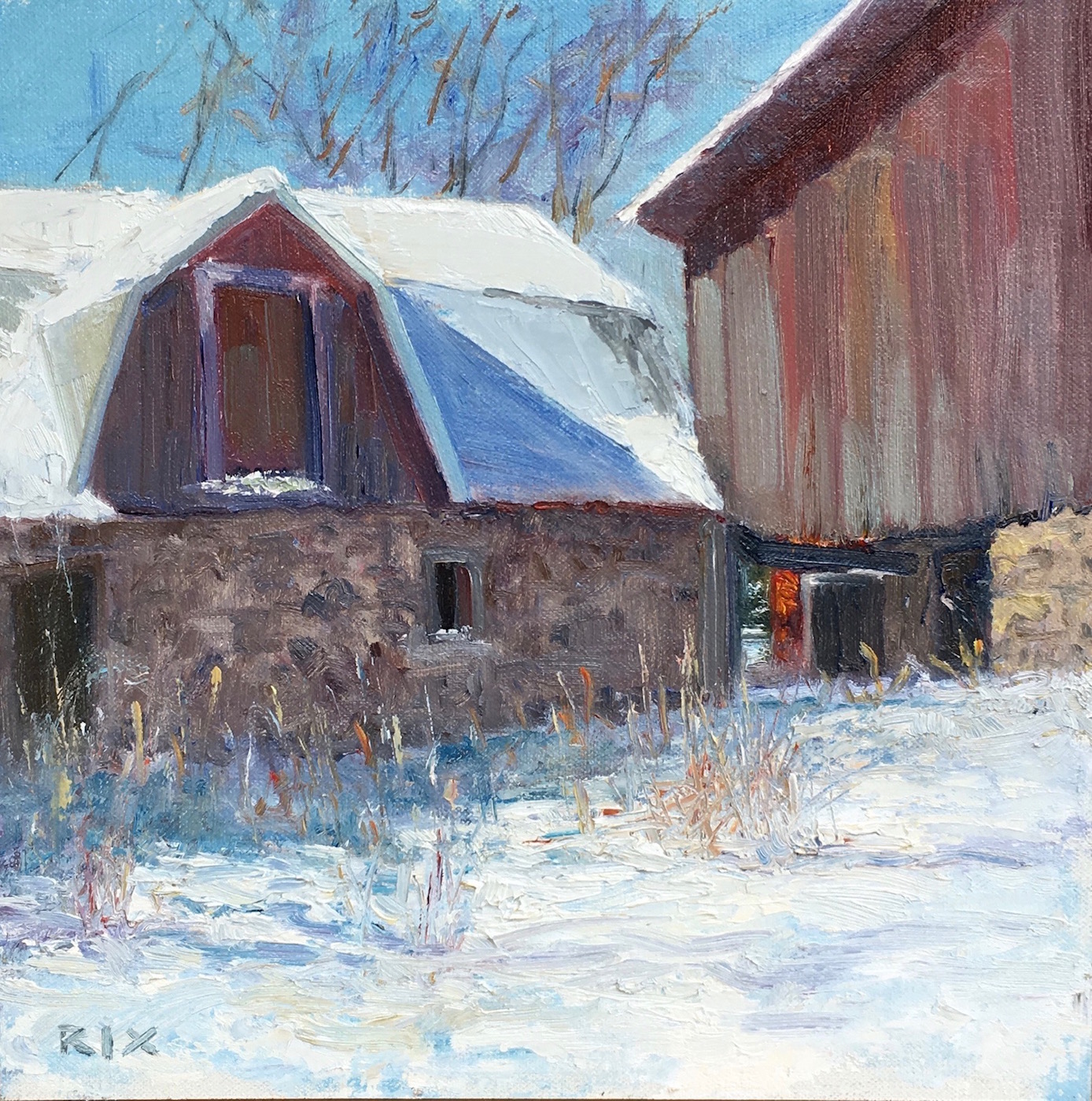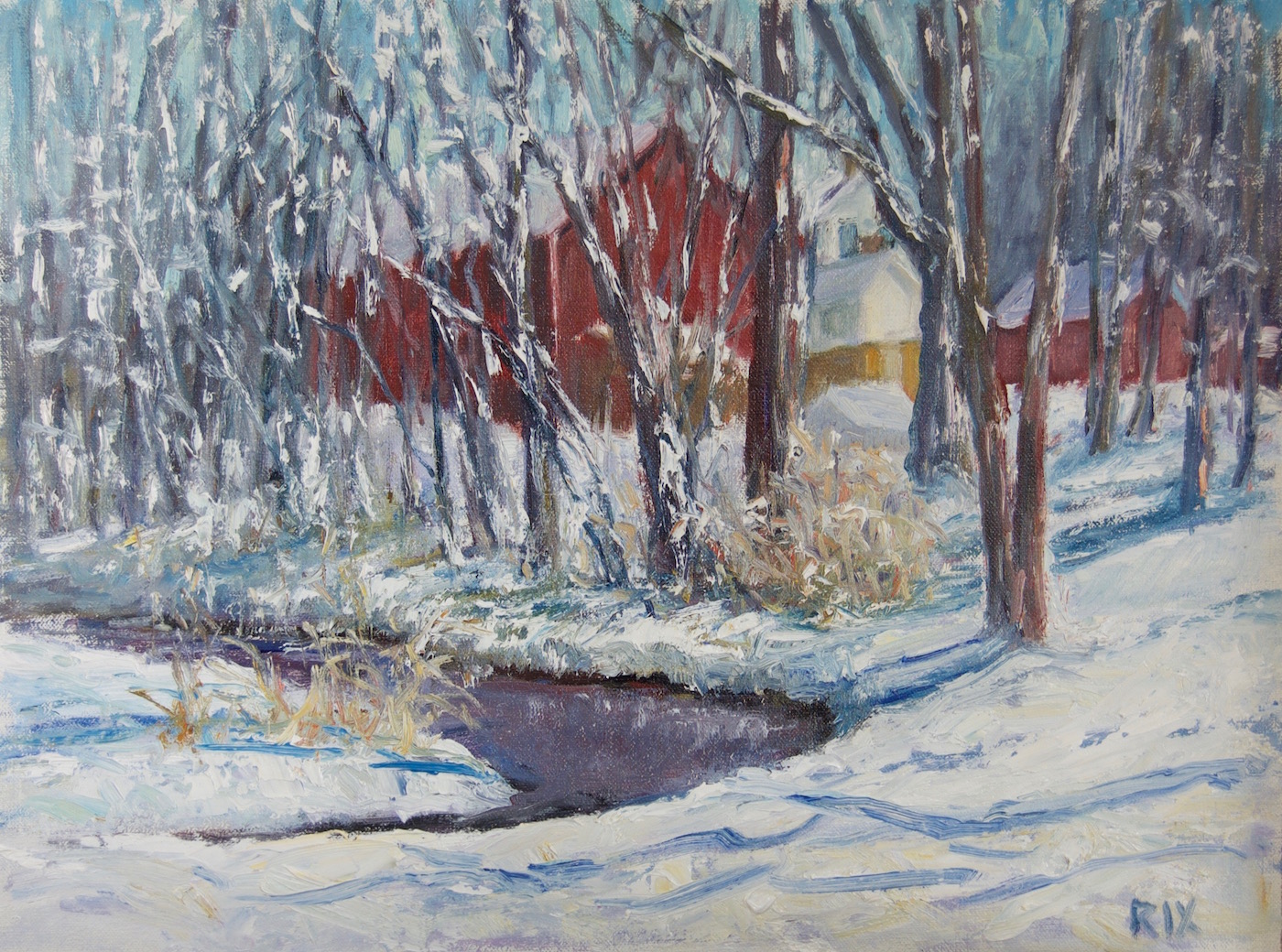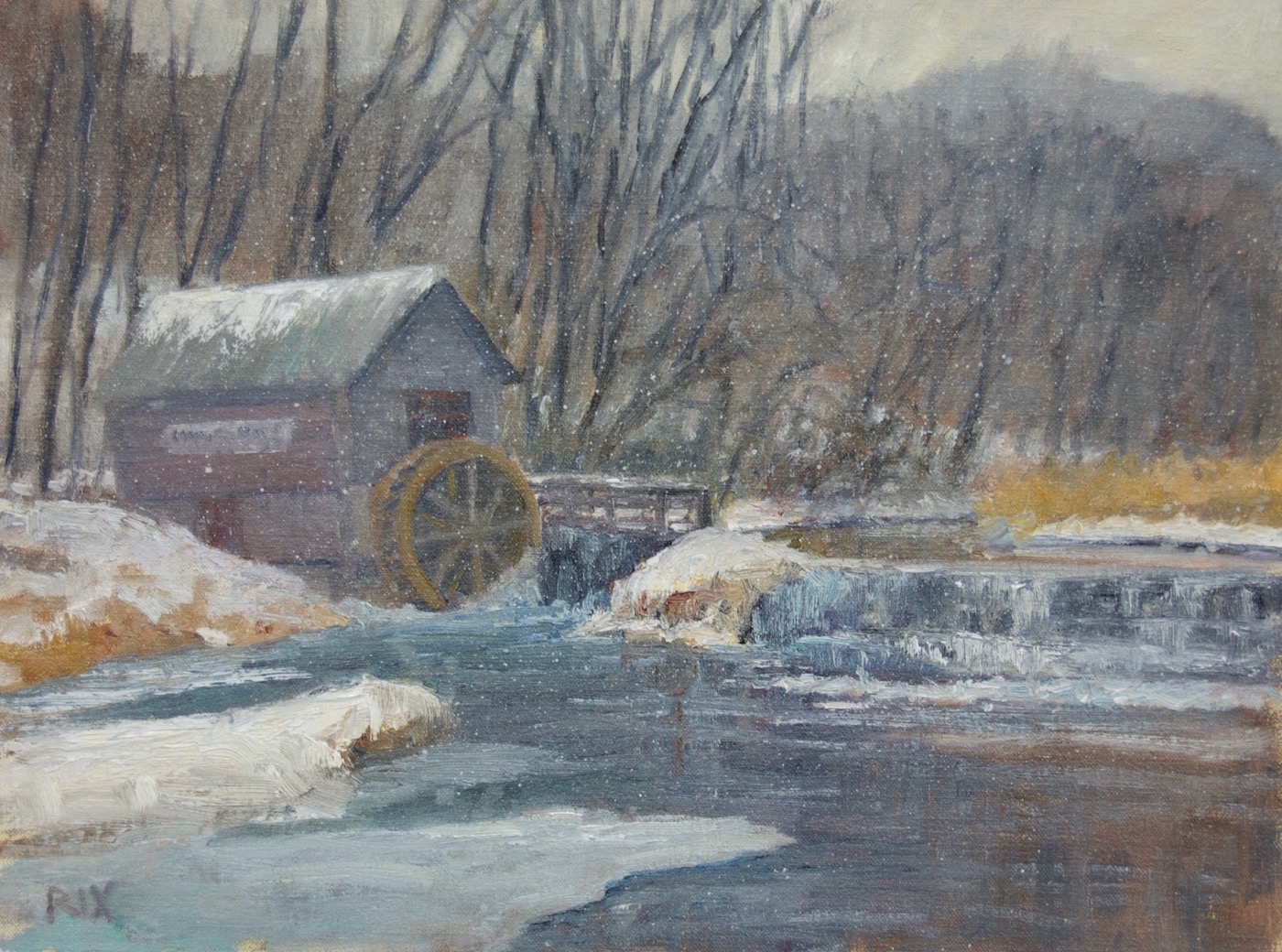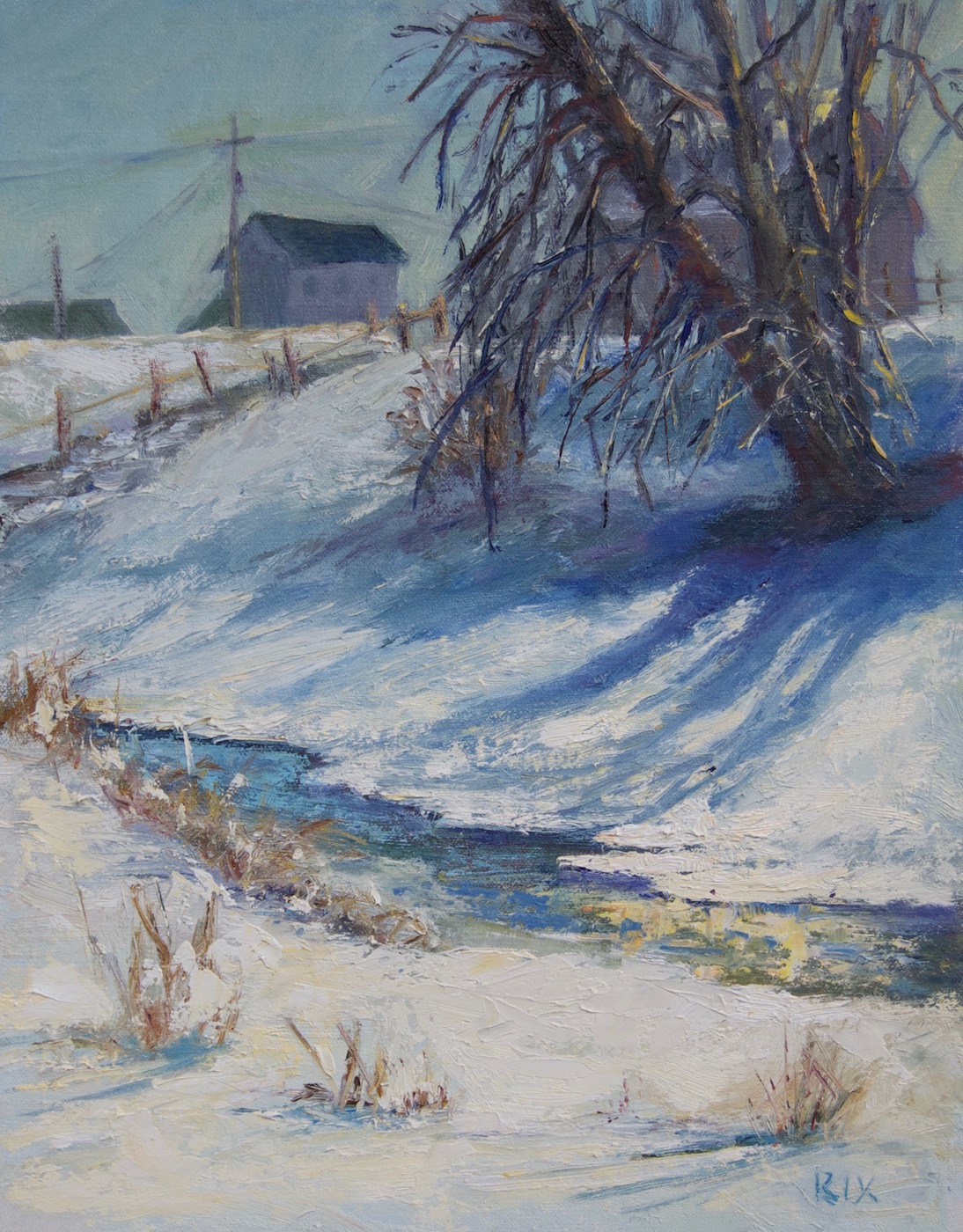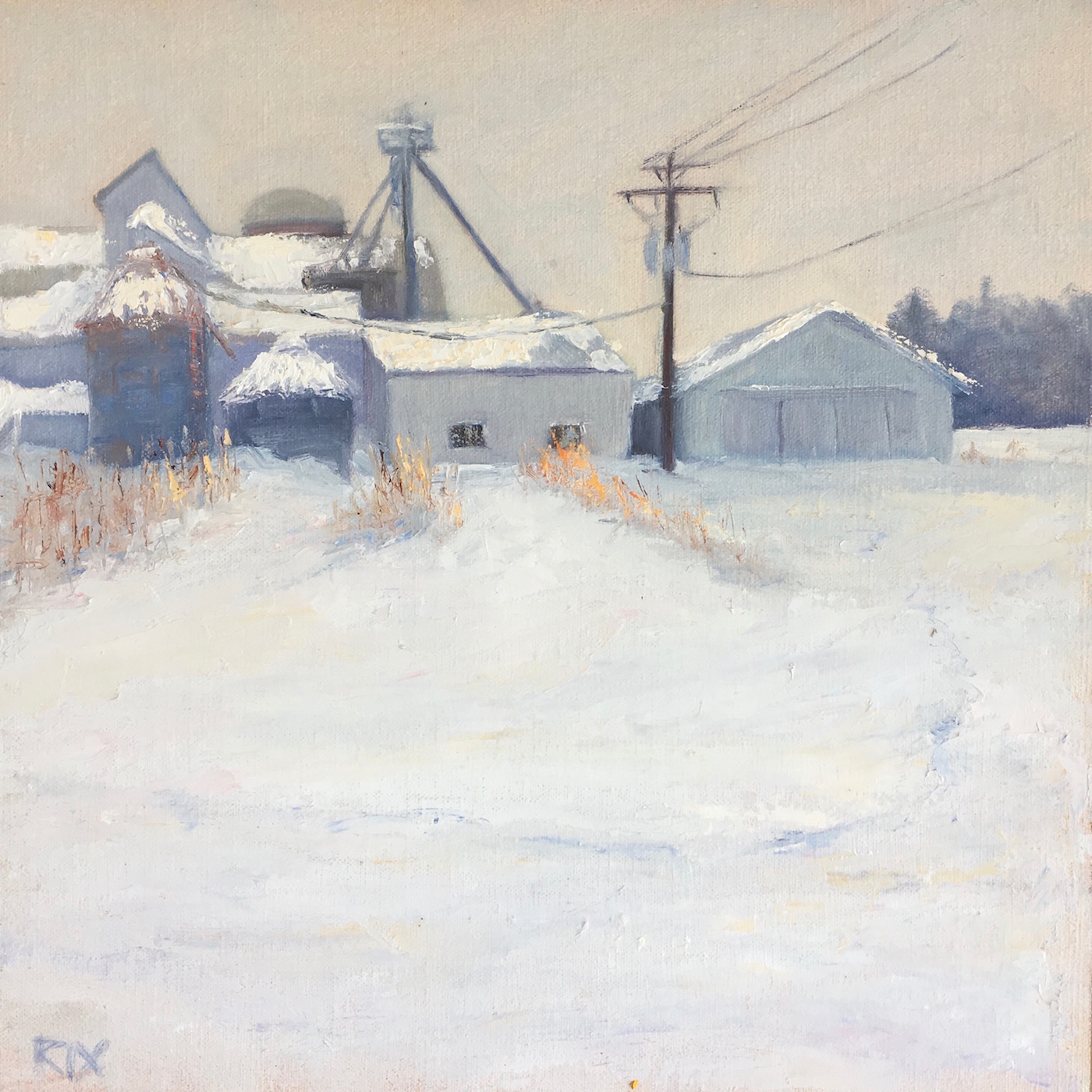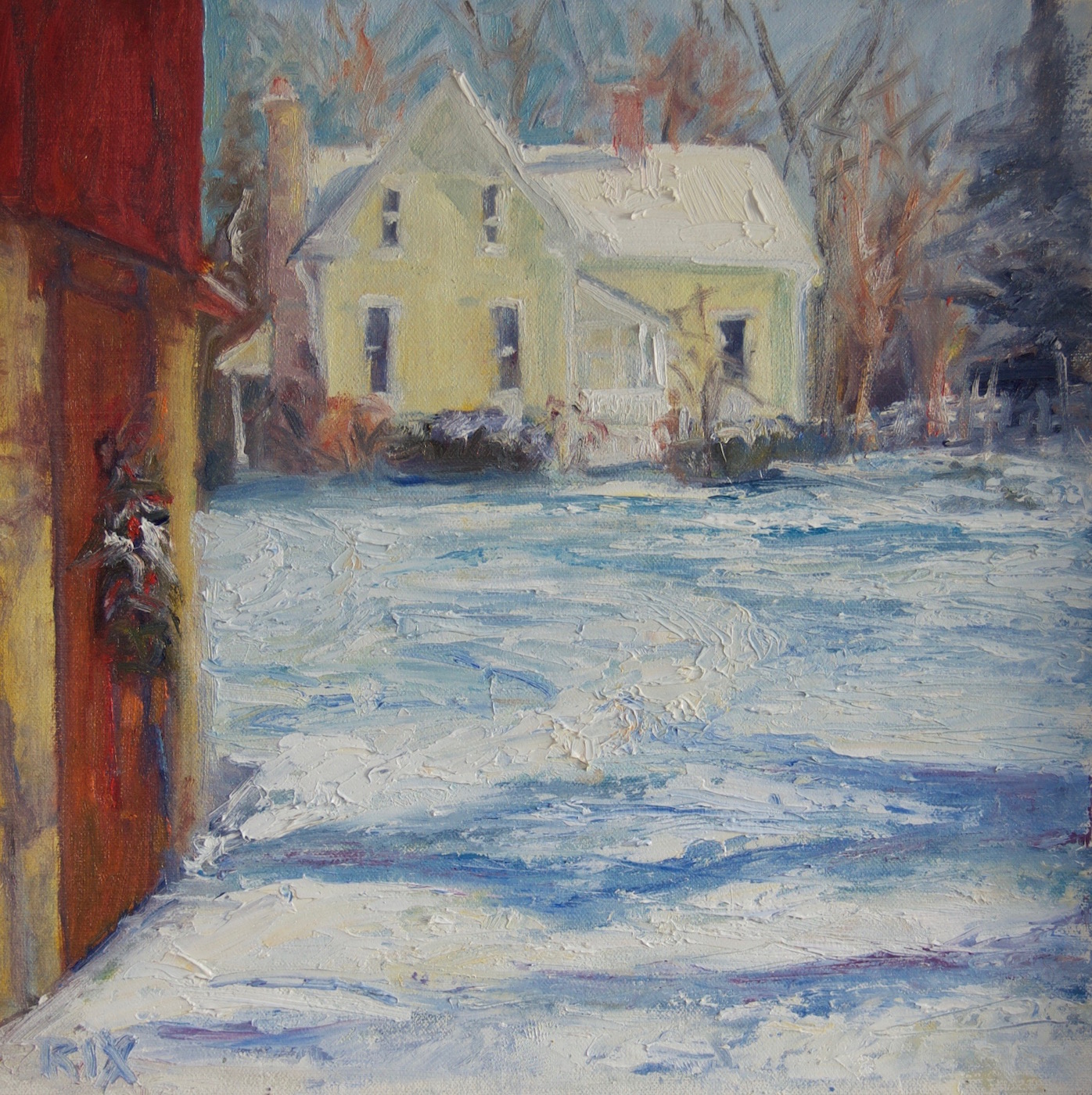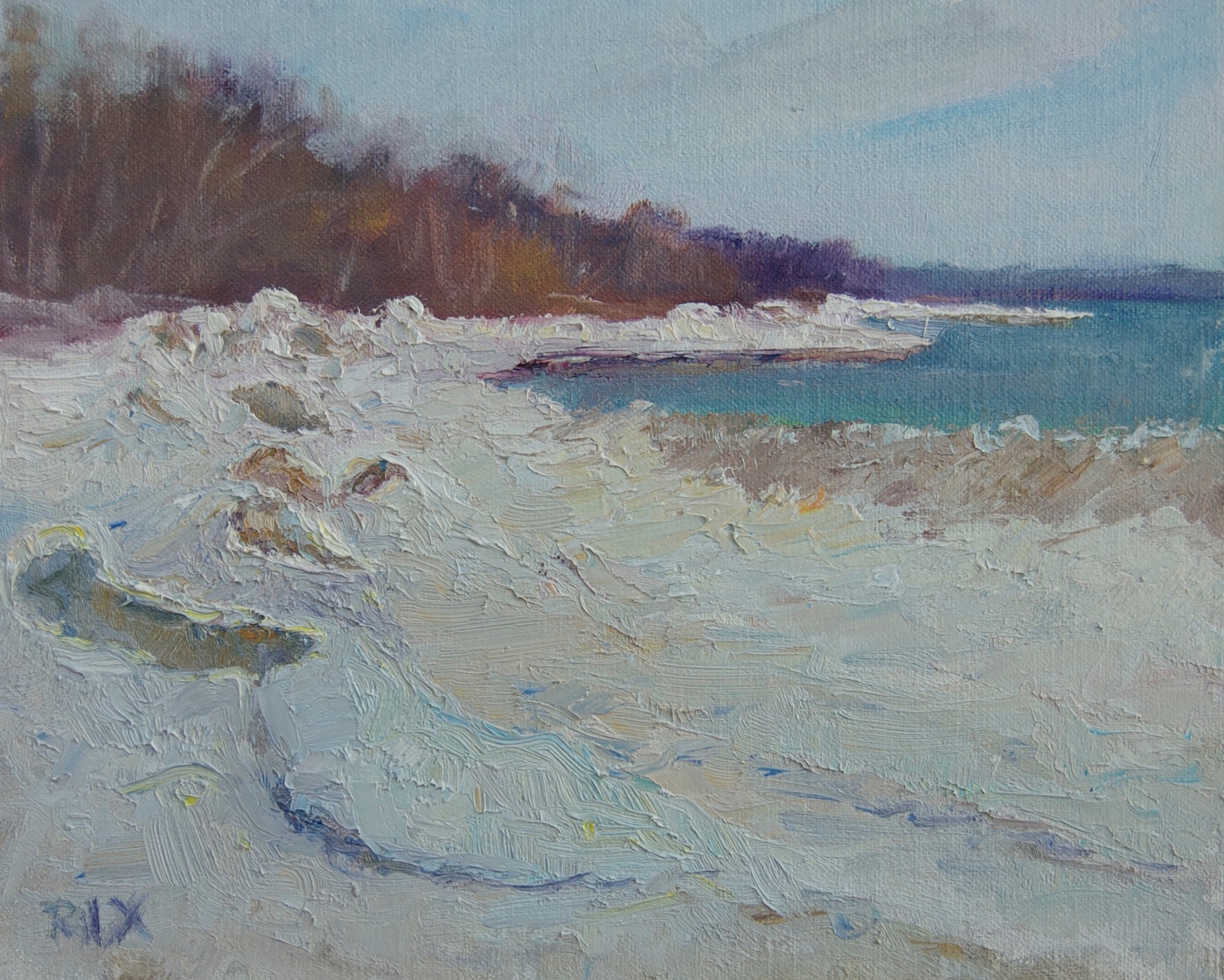LYNN RIX
EMBRACING WINTER EN PLEIN AIR
December 2, 2019 – February 25, 2020
The landscape of Wisconsin offers a vast array of inspiration from lush forests to lakeside charm, however its winters are harsh and long. It is this bleak winter where painter Lynn Rix finds austere yet magical inspiration. Rix is an outdoor painter, following in the long tradition of en plein air artists. Rather than use sketches in her studio, Rix paints from life out of doors. In the winter this can be especially challenging, freezing temperatures, harsh conditions of snow, ice and wind, yet Rix finds these conditions focus her hand and cause spontaneity in her work.
Artist Biography
LYNN RIX began painting in 1995 while living in the south of France. Inspired by the beauty of the landscape, Rix began to put down on canvas her vision of the area’s atmosphere, sunlight, buildings, and everyday life. She usually works on smaller canvases in order to complete a painting in two to four hours, capturing the sun before it moves on. Rix particularly enjoys painting the Wisconsin rural landscape and small towns in all four of the seasons, although winter remains her favorite. Rix exhibits her work both locally and nationally and is an active member of many artist societies. www.lynnrix.com
Artist Interview
Inspiration (Backstory)
The following questions are intended to provide insight into the artist's process, how they got started and what inspires them.
Was there a person or event that got you started creating your art? Does that person or event continue to influence the work that you do?
I grew up on a lake in Waukesha County in the 50s. Both of my parents valued nature and doing things outside. I spent most of my free time outdoors, in all Wisconsin seasons! The lake and the surrounding countryside was my playground and my quiet place. I am sure that is why I am a plein air artist instead of a studio artist. I find painting outside to be way more inspiring, invigorating, and at the same time relaxing than painting in the studio. My mother entertained us by doing creative projects. We always made homemade presents for our grandparents and family. My mom and some of her friends started a puppet theatre when I was small. We have a photo of me at about four years old watching them create. I imagine that was most likely my first “art experience”. My parents also instilled in me the love of problem solving and creative thinking. As an artist, I have to continue to problem solve as I create my own vision of what nature and man has put in front of me. I am more often than not, frustrated with what I am doing, but have found enough joy that I want to “ try again another day”. Never bored, always challenged, always learning: traits I learned from my parents.
At what point did you consider yourself an artist?
I am not sure when I became comfortable calling myself an artist. I am sure it was a very gradual process. In 1995, my husband, our daughter and I moved to the south of France for a year. My daughter to go to school, my husband to live his college dream, and me to have an adventure. That year would change my life completely. I was surrounded by art and artists both past and present. One day, I was returning from French class and looking in an art gallery window when an English man stopped me and asked if I would be interested in looking at his art. I said sure. He quickly returned with three paintings. All a bit different, all mesmerizing, and all painted on the streets of the historic local villages. I told him I wasn’t interested in buying them but would be interested in learning how to paint. Would he teach me? His answer changed my life. I began painting classes with my first mentor, Mitch Waite. First in his garret apartment from photos and then out on the street. I was very fortunate that he was a self-taught artist as it kept all of his lessons very simple, direct and full of common sense. I was on my way to becoming addicted to creating on canvas. I was 47 years old.
Who or what inspires you and why?
I am drawn to impressionist work, both historic and contemporary. My historic favorites are Camille Pissarro ,Aldro Hibbard and John Carlson. All painted winter plein air, all were caring, giving mentors to other artists. I wish I had known them and been able to paint beside them. Some of the contemporary artists who have influenced me in plein air are Daniel Gerhartz, Chris Magadini, Rosalie Nadeau,Stapleton Kearns, and Lori Beringer among many other friends in the plein air world. Painting en plein air on a crisp Wisconsin winter day is my absolute favorite inspiration. The sun shining brilliantly after a snowfall, the reflective white of the snow , the longer more dramatic shadows, the kaleidoscope of vibrant color that begs me to paint. On grey days, the light is muted and yet warm and cold at the same time; a challenging juxtaposition. Being out in the elements is a huge part of my inspiration and joy of painting. The calm, quiet and simplicity of the “snow-white” landscapes bring me peace while the ice cold air energizes and renews me. It is absolutely my favorite time of year.
Are there any programs or learning opportunities that you wish you had as a young artist?
I am grateful for the opportunities my parents gave me. Art ( making things ) was just always a part of my life. Without this background of creative thinking and risk taking, I most likely would have never had the guts to ask Mitch Waite to teach me in the streets of France.
What would you say to a young person to encourage their study and practice of art?
I believe that art is fundamental to making a human being different from other animals. I would encourage all children and adults to practice the art of making things. To create is to take risks, to problem solve and to be a part of your surroundings. Every time someone makes art, they must really look at what is happening around them, edit out the superfluous, make a decision as to what they want to say and how they want to say it. If a “mistake” is made, they must learn from it, scrape it and start anew. Risk-taking, problem-solving, creative thinking and feeling : that is being a living human being; that is having the joy of being an artist.
Artistic Practice
The following questions are intended to create insight into the artist’s practice and why they think art is important.
Is this your first and only career? If not, what other jobs have you had and how have they influenced your artistic practice?
I have had many “careers” in my life time. All of which shaped me and consequently must have influenced by artistic practice.
* A parent and grand-parent : creative thinking and risk taking at its zenith !
* A middle school math teacher, a Montessori teacher: gave me the joy of problem-solving. After all, painting is really just puzzle solving and shape making.
* Designing, sewing and selling a children’s clothing line : The designing part had some artistic sense to it, but I never thought of myself as an artist while doing it. I just enjoyed sewing and coming up with cute things for kids to wear.
* An Antique dealer: the skill to see beneath the surface and also to visually market my “stuff” to be things of beauty.
* Designing and making one of a kind Santa Clauses : I didn’t think of this as being an artist, just “playing with dolls”! But of course, I was making design decisions and making a decorated Christmas heirloom. Perhaps a work of art?
Do you like people to see your work/comment on it while it is still in process? Why?
Being a plein air artist, I am always out in the open while creating. Sometimes, I am off on my own, but always in a place where it is possible for someone to happen by. I welcome comments and enjoy answering questions while I work. Always like to educate people on the joys of making art. I also value critiques and suggests from other artists. A fresh pair of eyes is always welcome, after-all I am painting not just for myself, but for others to enjoy.
Do you have a daily artistic ritual or routine? If so, how does this help you?
No daily routine or ritual. Each day is different with my life as a mother, wife, grand-mother, Board member on two non-profit boards. I do exercise every day . This may sound strange as an artistic routine, but exercise not only frees up my mind for the creative process, but also keeps my body strong and healthy... I need to haul a lot of gear when I paint !
What inspiration/research led you to your current body of work?
In 2010 , an artist friend who had never painted a winter plein air piece got me outside to paint my first winter plein air. She invited me to paint with her at Schlitz Audubon while her son was in preschool. We started out in the fall painting one morning a week. Then winter hit, out we went on a beautiful sunny December day. I was hooked ! Since then, I have painted as much as I can every time there is snow in Wisconsin. And when there isn’t natural snow on the ground, I head to a local ski slope. I study works by winter plein air artists and as I mature in my painting, I continue to learn from them.
What caused you to gravitate toward the materials and processes you are currently using?
Obviously painting in the cold is really quite different than painting in warm weather. Keeping my body warm is not only a safety measure but a comfort measure. Silk long underwear, turtleneck, fleece top and bottom, insulated bib overalls, parka, face mask, ski hat and hat with visor. Wool socks and heavy duty boots with cleats. My hands are my weak point. Because of skiing for so many years, my fingers have been frost bitten too many times to count. Add in some arthritis and you get pain. Gloves, mitts, hand warmers, and a great product called “Warm Skin” all of these work to some extent. But, when the temperature goes way below zero and the wind kicks in, my hands hurt ! A few years ago, I came across an article on the Hibbard Mitt. He used wool socks with a slit cut out layered over mittens. I tried this with limited results as it was so unwieldy. I then came up with an idea that worked! I cut one of my old hand knit wool sweaters with an allover pattern ( lots of carried yarn in the back giving it more thickness ) into a thumbless mitten. Layering this wool mitt over a mitten liner with a pouch for a hand warmer has proved to keep my frost bitten fingers warm. Oil paint will never freeze, but it does change consistency as the thermometer drops, becoming a little like painting with toothpaste and sometimes it gets an added grit of ice crystals. I find a little more use of a medium ( walnut or linseed oil) helps and a lot more use of the palette knife. The biggest adaption is the time constraint. The colder it is, the shorter the time in front of the easel. No lingering around making small tweaks. When the paint becomes completely unmanageable or I get cold and dehydrated, it is definitely packing up time!
Current Work
The following questions are intended to offer insight into the artist’s current work and what they intend their audience to understand.
What role does process have in your work?
Process or technique is very important in creating my paintings. I am continually learning and trying to improve my knowledge of the “how-to”; however, more important to me is imparting the feeling of the painting. I am not trying to paint a literal replica of what I am looking at. My paintings are not meant to be photographs. I paint because I am inspired by the beauty of what I see. I want to give the viewer a sense of what my heart is saying.
How do you know when a piece is complete?
Sometimes the work tells me it is finished. Other times, it is the point at which I have nothing else to say. And still other times, I may go back into a older piece that needs resolving. A problem solved long after the painting was “completed”.
What is the one idea/thought you hope people will have/take away with them after viewing your work?
Wisconsin is an absolutely gorgeous in winter ! Get outside and enjoy it ! Open your eyes and really look at the shapes and colors in snow and ice. Mother Nature isn’t sleeping, she is just taking a beauty rest.
Why do you create art?
That is a difficult question to answer. I have always created things. Hand-knit sweaters, hand-hooked rugs, clothes, baskets, jewelry, and the list goes on. It is just part of who I am. I also think that it is my “therapy”. When I am standing in front of my canvas, the rest of the world goes away. I am completely engrossed in the process and the feeling. Relaxed, challenged, exhausted, inspired, joyful, meditative , all at the same time!
What role does the artist have in society? Why do you think art is important to society?
The artist has the ability to make us see, to make us feel, to make us think outside of ourselves. To give people a sense of hope and community. To bring beauty and refresh memories. Art is important to society for all of the above reasons, but also to emphasize the importance of problem-solving, risk taking and creative thought for everyone.
Why do you think it’s important to support the arts?
Art-making is fundamental to being human. Visual art is communication without the need of words. It is cross cultural. We need artists and creative thinkers to keep the human race human. Robots and computers do not think, create or take risks. Humans do. To quote my aunt, who also became an artist when in her late forties,
“ Art is personalized. It is the conscious elevation of the ordinary. It is the flame within us. The release of creative energy is indeed a tiger. Once having felt that experience , one can not let the tiger go.”
